The objective of the Law is to ensure public safety by regulating production, storage, sale, transportation and other handling and consumption of, along with production and handling of the containers for high-pressure gases, and by promoting voluntary activities by private businesses and the High Pressure Gas Safety Institute of Japan regarding the safety of high-pressure gases.
(2) OUTLINE OF THE LAW AND SYSTEM
Manufactured or imported containers must pass the container inspection by the High Pressure Gas Safety Institute or other designated agencies and receive stamping or marking plate indicating their passage before being transferred or delivered (Article 44).
Among the equipment for high-pressure gas production, those designated by the Ordinance of the Ministry of Economy, Trade and Industry as especially requiring inspections on either design, material quality, or the manufacturing process to prevent explosion and other occurrence of disasters regarding high-pressure gas (hereinafter referred to as "Designated Equipment") are to go through, when manufactured or imported, Designated Equipment Inspection conducted by agencies including the High Pressure Gas Safety Institute. Foreign manufacturers of Designated Equipment for export to Japan may apply for the Designated Equipment Inspection by the High Pressure Gas Safety Institute and others. In such cases, the applicant for the Inspection must submit application for the Inspection before the import of the Designated Equipment (Article 56-3).
Reflecting the difference in dangers among the types of gasses, importers of high-pressure gas can transfer the import only after confirmation of the type of gas and tests to certify compliance to technical standards for container safety, conducted by the governor of the prefecture of the landing port (Article 22). Furthermore, private companies, etc. will become involved in the implementation of importation inspections from July 1, 2000.
With respect to aerosol and other high-pressure gas exempted from the application of the Law, confirmation is conducted at the time of importation in order to identify whether or not the imported product is exempted in accordance with the Law by using inspection data previously issued by a Japanese or foreign inspection agency (including any inspector certified by a public agency) or the manufacturer's or importer's own inspection data on products of aerosol, etc. conducted by a manufacturer or an importer.
(3) CABINET ORDER AND MINISTRIAL ORDINANCES
Enforcement Order of the High-pressure Gas Safety Law
General High-pressure Gas Safety Regulations
Liquefied Petroleum Gas Safety Regulations
Container Safety Regulations
Refrigeration Safety Regulations
Designated Equipment Inspection Regulations etc.
(4) OUTLINE OF THE CONTROL
1) Items Covered
High-pressure gas, their containers and designated equipment
2) Outline of Specifications, Standards and Inspections, etc.
In the case of inspecting any of these products, foreign inspection data are used as much as possible in order to simplify the inspection procedure. Furthermore, all the inspection standards are clearly and definitely prescribed by laws and regulations.
In the case of importing high-pressure gas, the type of gas shall be confirmed by comparing a description of imported high-pressure gas with actual gas, and the conformity to technical standards of its container shall be inspected (Article 22).
In the case of importing any high-pressure gas container, the conformity to technical standards of the container shall be inspected. Furthermore, a "registered container manufacturer" is permitted to conduct a self-inspection in place of an inspection conducted by a public agency (Article 44).
In the case of importing Designated Equipment, the conformity to technical standards of the high-pressure gas equipment is examined. Furthermore, it is permitted for "Designated Equipment manufacturers" to carry out self-inspection in place of inspections conducted by public bodies (Article 56-3).
In the case of importing aerosol products, an exhibition of test performance documentation (the one implemented by a manufacturer of the product in question is also acceptable) is required in order to confirm its conformity to requirements for exemption from an application of the Law.
Incidentally, "registered manufacturers" (registered container manufacturers and registered Designated Equipment manufacturers") mean manufacturers passed conformity assessment for manufacturing facilities, testing equipment or a quality control system, and registered by the Ministry of Economy, Trade and Industry (Article 49-5, etc.).
[Flowchart of the certification system]
i. High-pressure gas containers (cylinders)
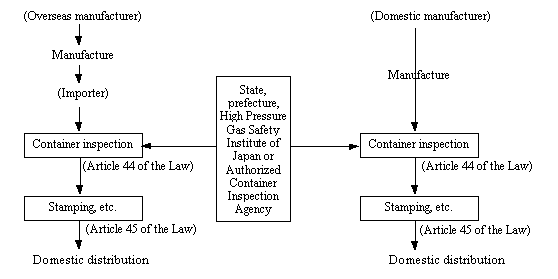
ii. Accessories
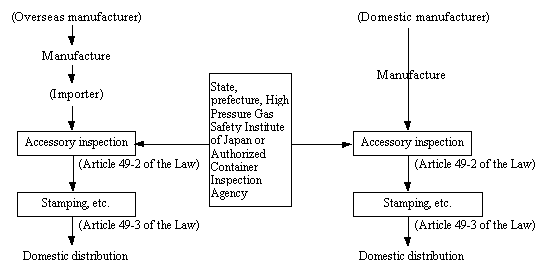
(Note) Measures have been taken to speed up the above procedures (i, ii) by accepting certain foreign testing data at the time of inspections. In concrete terms, Japan accepts data of five countries including the US, the UK, France, Germany and Australia as well as US-IIA located outside US.
iii. Specific equipment
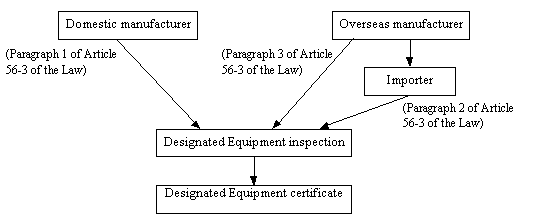
(Note) Measures have been taken to speed up the above procedures for (iii) by accepting certain foreign testing data at the time of inspections.
iv. Certification System of registered establishments
(a) High-pressure gas containers
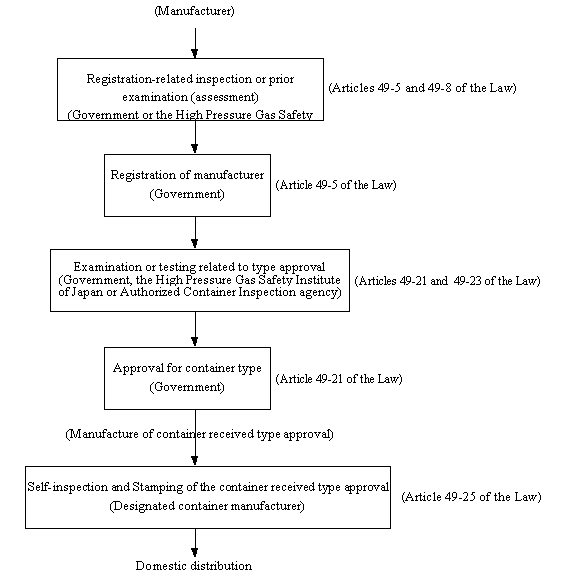
* The certification system applies to accessories also. The certification system may also apply to overseas manufacturers.
(b) Specific equipment
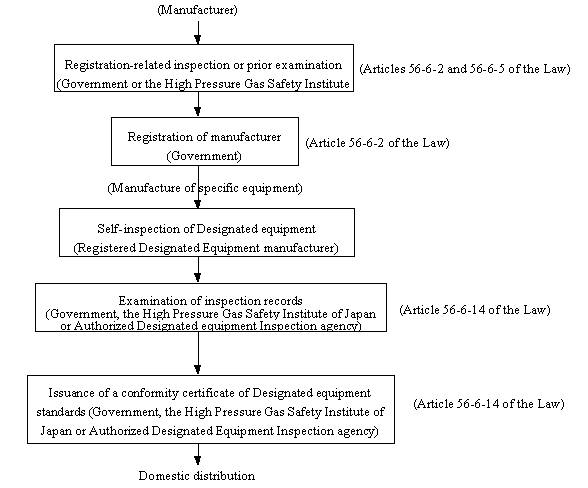
* The certification system may apply to overseas manufacturers.
(5) HIGHLIGHTS OF THE RECENT AMENDMENT
Since a registered establishment system was introduced, it becomes possible for manufacturers themselves to carry out self-inspections if they satisfy necessary requirements. This system is also open to overseas manufacturers (enforcement from April 1997).
In response to the 3-year Plan for Promotion of Regulatory Reform (Revised) (Cabinet Approval on March 29, 2002), which accepted the technical standards set by the American Society of Mechanical Engineers (ASME) for high-pressure containers as prescribed in the High Pressure Gas Safety Law as a standard example, ASME Standards were added to the technical standards regarding Designated Equipment Inspection (enforcement from March, 2003).
Partial amendment included a revision on operation of functional standards in provisions such as Regulations for Designated Equipment Inspection (enforcement from March, 2003).
(6) REFERENCE INFORMATION
(Liaison Offices for Further Information)
Industrial Safety Division, Agency for Nuclear and Industrial Safety
Ministry of Economy,Trade and Industry
Tel: 03-3501-1706 http://www.meti.go.jp
High Pressure Gas Safety Institute of Japan
Tel: 03-3436-6100 http://www.khk.or.jp